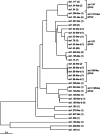Increased prevalence of group A streptococcus isolates in streptococcal toxic shock syndrome cases in Japan from 2010 to 2012
- PMID: 25703404
- PMCID: PMC9507079
- DOI: 10.1017/S0950268814001265
Increased prevalence of group A streptococcus isolates in streptococcal toxic shock syndrome cases in Japan from 2010 to 2012
Abstract
Streptococcal toxic shock syndrome (STSS) is a severe invasive infection characterized by the sudden onset of shock, multi-organ failure, and high mortality. In Japan, appropriate notification measures based on the Infectious Disease Control law are mandatory for cases of STSS caused by β-haemolytic streptococcus. STSS is mainly caused by group A streptococcus (GAS). Although an average of 60-70 cases of GAS-induced STSS are reported annually, 143 cases were recorded in 2011. To determine the reason behind this marked increase, we characterized the emm genotype of 249 GAS isolates from STSS patients in Japan from 2010 to 2012 and performed antimicrobial susceptibility testing. The predominant genotype was found to be emm1, followed by emm89, emm12, emm28, emm3, and emm90. These six genotypes constituted more than 90% of the STSS isolates. The number of emm1, emm89, emm12, and emm28 isolates increased concomitantly with the increase in the total number of STSS cases. In particular, the number of mefA-positive emm1 isolates has escalated since 2011. Thus, the increase in the incidence of STSS can be attributed to an increase in the number of cases associated with specific genotypes.
Keywords: streptococcal toxic shock syndrome.
Conflict of interest statement
None.
Figures



Similar articles
-
Molecular characterization and antibiotic resistance of Streptococcus dysgalactiae subspecies equisimilis isolated from patients with streptococcal toxic shock syndrome.J Infect Chemother. 2018 Feb;24(2):117-122. doi: 10.1016/j.jiac.2017.09.013. Epub 2017 Nov 6. J Infect Chemother. 2018. PMID: 29107650
-
Epidemiology of an upsurge of invasive group A streptococcal infections in Ireland, 2012-2015.J Infect. 2018 Sep;77(3):183-190. doi: 10.1016/j.jinf.2018.05.010. Epub 2018 Jun 20. J Infect. 2018. PMID: 29935196
-
Molecular characterization and antimicrobial resistance of group A streptococcus isolates in streptococcal toxic shock syndrome cases in Japan from 2013 to 2018.Int J Med Microbiol. 2021 Apr;311(3):151496. doi: 10.1016/j.ijmm.2021.151496. Epub 2021 Mar 17. Int J Med Microbiol. 2021. PMID: 33756191
-
Severe group A streptococcal infection and streptococcal toxic shock syndrome.Can J Anaesth. 2000 Nov;47(11):1129-40. doi: 10.1007/BF03027968. Can J Anaesth. 2000. PMID: 11097546 Review.
-
Toxic Shock Syndrome (TSS) Caused by Group A Streptococcus: Novel Insights Within the Context of a Familiar Clinical Syndrome.J Korean Med Sci. 2024 May 6;39(17):e154. doi: 10.3346/jkms.2024.39.e154. J Korean Med Sci. 2024. PMID: 38711318 Free PMC article. Review.
Cited by
-
Spontaneous mutations in Streptococcus pyogenes isolates from streptococcal toxic shock syndrome patients play roles in virulence.Sci Rep. 2016 Jun 28;6:28761. doi: 10.1038/srep28761. Sci Rep. 2016. PMID: 27349341 Free PMC article.
-
Prothrombotic and Proinflammatory Activities of the β-Hemolytic Group B Streptococcal Pigment.J Innate Immun. 2020;12(4):291-303. doi: 10.1159/000504002. Epub 2019 Nov 19. J Innate Immun. 2020. PMID: 31743913 Free PMC article.
-
Colonization of β-hemolytic streptococci in patients with erysipelas-a prospective study.Eur J Clin Microbiol Infect Dis. 2019 Oct;38(10):1901-1906. doi: 10.1007/s10096-019-03625-9. Epub 2019 Jul 10. Eur J Clin Microbiol Infect Dis. 2019. PMID: 31292789 Free PMC article.
-
Genetic Characterization of Streptococcus pyogenes emm89 Strains Isolated in Japan From 2011 to 2019.Infect Microbes Dis. 2020 Oct 21;2(4):160-166. doi: 10.1097/IM9.0000000000000038. eCollection 2020 Dec. Infect Microbes Dis. 2020. PMID: 38630060 Free PMC article.
-
Genome sequence analysis of emm89 Streptococcus pyogenes strains causing infections in Scotland, 2010-2016.J Med Microbiol. 2017 Dec;66(12):1765-1773. doi: 10.1099/jmm.0.000622. Epub 2017 Nov 3. J Med Microbiol. 2017. PMID: 29099690 Free PMC article.
References
-
- Smeesters PR, McMillan DJ, Sriprakash KS. The streptococcal M protein: a highly versatile molecule. Trends in Microbiology 2010; 18: 275–282. - PubMed
-
- Muller-Eberhard HJ. The membrane attack complex of complement. Annual Review of Immunology 1986; 4: 503–528. - PubMed
-
- Hoe NP, et al. Rapid selection of complement-inhibiting protein variants in group A Streptococcus epidemic waves. Nature Medicine 1999; 5: 924–929. - PubMed
MeSH terms
Substances
LinkOut - more resources
Full Text Sources
Other Literature Sources
Medical

